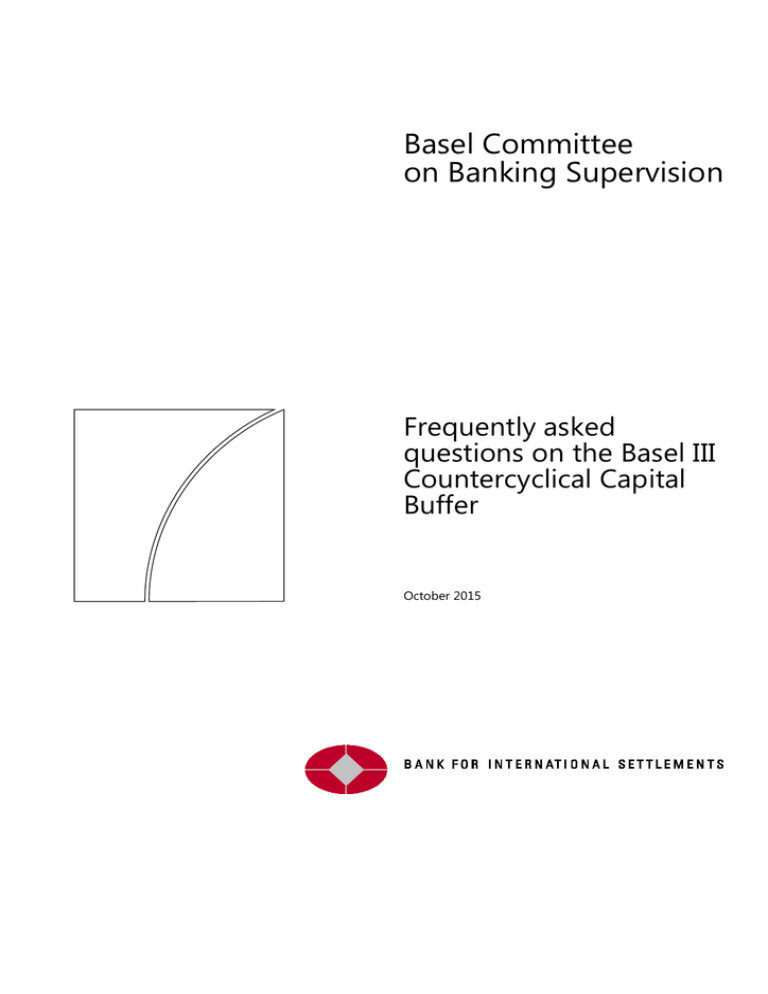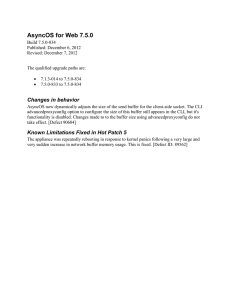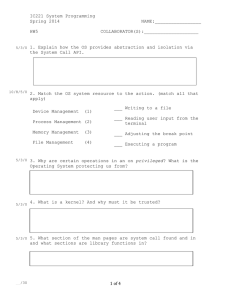
Basel Committee
on Banking Supervision
Frequently asked
questions on the Basel III
Countercyclical Capital
Buffer
October 2015
This publication is available on the BIS website (www.bis.org).
©
Bank for International Settlements 2015. All rights reserved. Brief excerpts may be reproduced or
translated provided the source is stated.
ISBN 978-92-9197-286-9 (online)
Contents
Frequently asked questions on the Basel III Countercyclical Capital Buffer .............................................................. 1
Introduction ......................................................................................................................................................................................... 1
1.
National buffer decisions ............................................................................................................................................. 1
Questions related to national buffer decisions ............................................................................................................ 2
2.
Jurisdictional reciprocity............................................................................................................................................... 3
Questions related to jurisdictional reciprocity.............................................................................................................. 3
3.
Identification and calculation of geographic credit exposures .................................................................... 4
Questions related to the identification and calculation of geographic credit exposures ........................... 5
4.
Calculation of the final bank-specific buffer add-on ........................................................................................ 5
Questions related to the final bank-specific buffer add-on.................................................................................... 5
5.
Public disclosure requirements ................................................................................................................................. 6
Questions related to public disclosure requirements ................................................................................................ 7
6.
Timing and frequency of changes in the buffer rates ...................................................................................... 8
Questions related to timing and frequency of changes in the buffer rates ..................................................... 8
Annex: Identifying geographic location of exposures ........................................................................................................ 9
Frequently Asked Questions on the Basel III Countercyclical Capital Buffer
iii
Frequently asked questions on the Basel III Countercyclical
Capital Buffer
Introduction
In 2010, the Basel Committee on Banking Supervision released the Basel III capital standards. The
countercyclical capital buffer forms an integral part of the standards for risk-based capital, with
implementation beginning in 2016, as described in Basel III: A global regulatory framework for more
resilient banks and banking systems. In December 2010, the Basel Committee issued further information
on procedures for operating the countercyclical capital buffer regime in Guidance for national authorities
operating the countercyclical capital buffer. This document provides excerpts from those papers, as well
as some clarifications, particularly on the role of jurisdictional reciprocity, and the computation of the
capital buffer add-on.
The countercyclical capital buffer aims to ensure that banking sector capital requirements take
account of the macro-financial environment in which banks operate. Its primary objective is to use a
buffer of capital to achieve the broader macroprudential goal of protecting the banking sector from
periods of excess aggregate credit growth that have often been associated with the build-up of systemwide risk. Due to its countercyclical nature, the countercyclical capital buffer regime may also help to
lean against the build-up phase of the credit cycle in the first place. In downturns, the regime should
help to reduce the risk that the supply of credit will be constrained by regulatory capital requirements
that could undermine the performance of the real economy and result in additional credit losses in the
banking system.
The Basel III countercyclical capital buffer is calculated as the weighted average of the buffers in
effect in the jurisdictions to which banks have a credit exposure. It is implemented as an extension of the
capital conservation buffer. It consists entirely of Common Equity Tier 1 capital and, if the minimum
buffer requirements are breached, capital distribution constraints will be imposed on the bank.
Consistent with the capital conservation buffer, the constraints imposed relate only to capital
distributions, not the operation of the bank.
The countercyclical capital buffer regime will be phased-in in parallel with the capital
conservation buffer between 1 January 2016 and end-2018, becoming fully effective on 1 January 2019.
This means that, for example, if activated at a value of 2.5% of risk-weighted assets (RWA), reciprocity of
up to 0.625% (2.5% divided by 4) of RWA is required on 1 January 2016 and this rate will increase each
subsequent year by an additional 0.625 percentage points, to reach its final value of 2.5% of RWA on 1
January 2019. Jurisdictions may choose to reciprocate beyond these rates. Jurisdictions that experience
excessive credit growth during this transition period may consider accelerating the build-up of the
countercyclical buffer.
1.
National buffer decisions
To make decisions regarding the level of the countercyclical capital buffer add-on, domestic authorities
are required to monitor credit growth and make assessments of whether such growth is excessive,
leading to the build-up of system-wide risk. Given differences across jurisdictions, there is no global
minimum standard for an assessment framework.
Frequently Asked Questions on the Basel III Countercyclical Capital Buffer
1
Authorities are expected to apply judgment in setting the buffer in their jurisdiction after using
the best information available to gauge the build-up of system-wide risks that signal the need to
activate the countercyclical capital buffer. Nevertheless, as an internationally consistent buffer guide,
authorities are expected to calculate the credit-to-GDP guide, which serves as a common reference point
for taking buffer decisions. Authorities are not expected to rely on this guide mechanistically, but rather
to incorporate the best information available, including expert judgment, when arriving at buffer
decisions. Therefore, the credit-to-GDP guide does not necessarily need to play a dominant role, but at
the same time it should not be disregarded.
Guidance for national authorities operating the countercyclical capital buffer sets out five
principles to assist authorities in determining an appropriate framework. It also discusses the calculation
and rationale for the buffer guide in greater detail. The five principles are:
Principle 1: (Objectives) Buffer decisions should be guided by the objectives to be
achieved by the buffer, namely to protect the banking system against potential future
losses when excess credit growth is associated with an increase in system-wide risk.
Principle 2: (Common reference guide) The credit-to-GDP guide is a useful common
reference point in taking buffer decisions. It does not need to play a dominant role in the
information used by authorities to take and explain buffer decisions. Authorities should
explain the information used, and how it is taken into account in formulating buffer
decisions.
Principle 3: (Risk of misleading signals) Assessments of the information contained in the
credit-to-GDP guide and any other guides should be mindful of the behaviour of the
factors that can lead them to give misleading signals.
Principle 4: (Prompt release) Promptly releasing the buffer in times of stress can help to
reduce the risk of the supply of credit being constrained by regulatory capital
requirements.
Principle 5: (Other macroprudential tools) The buffer is an important instrument in a suite
of macroprudential tools at the disposal of authorities.
Questions related to national buffer decisions
1.1
Is there a maximum level of the countercyclical capital buffer add-on and does it have to be set
in certain steps, eg in steps of 25bps?
Response – The countercyclical capital requirement that is relevant for the reciprocity
provision can vary between zero and 2.5% of RWA. National authorities can also
implement a buffer of more than 2.5% for banks in their jurisdiction, if they deem this as
appropriate in their national context. However, there are no requirements for other
countries to apply buffers above 2.5% when implementing reciprocity; they may choose
to do so at their discretion. In general, national authorities are free to choose the specific
level and can change the buffer add-on rate by whatever amount they deem necessary.
1.2
How should the credit-to-GDP guide be interpreted?
Response – The credit-to-GDP gap, calculated in accordance with the credit-to-GDP
guide, is a reliable indicator for periods of excess credit growth, in line with the objective
of the countercyclical capital buffer. As such, it is a measure of the credit cycle as distinct
from the business cycle. It should not be viewed as a deviation from, for instance, the
equilibrium level of credit in the economy. See Annex 1 of Guidance for national
authorities operating the countercyclical capital buffer for a more complete discussion.
2
Frequently asked questions on the Basel III countercyclical capital buffer
1.3
Is the credit-to-GDP guide unduly influenced by measurement problems?
Response – The internationally defined credit-to-GDP gap was found to be the best
performing measure from a statistical perspective in a range of early warning indicators
of incipient banking crises assessed in the Guidance document. Being based on credit, it
has the significant advantage over many other variables of appealing directly to the
objective of the countercyclical capital buffer. It often points to the correct timing and
provides stable signals, which are two important policy requirements. But, as it is not
immune to measurement problems, national authorities have to be mindful about these
when evaluating the credit-to-GDP guide. For instance:
2.
•
The credit-to-GDP gap is influenced by the behaviour of GDP as the denominator. If
the gap has risen purely because of a cyclical slowdown, for instance, this may not
always reflect a build-up of system-wide risks. Similarly, if the credit-to-GDP has
been trending upwards for a long time, the gap to the trend may be
underestimating the boom.
•
The trend underlying the credit-to-GDP gap requires sufficient data to be robust.
Ideally, there should be a minimum of 10 years of data before the trend is used.
•
As is typical for macroeconomic indicators, routine statistical revisions can affect the
underlying data. The available evidence, however, suggests that statistical revisions
do not impair the signalling quality of the credit-to-GDP gap.
Jurisdictional reciprocity
Jurisdictional reciprocity will be applied in the context of internationally active banks. Reciprocity ensures
that the application of the countercyclical buffer in a given jurisdiction does not distort the level playing
field between domestic banks and foreign banks with exposures to counterparties in the same
jurisdiction. Through this process, credit exposures to a private sector entity located in any given
jurisdiction will attract the same buffer requirement, irrespective of the location of the bank providing
credit (please see Section 3 regarding identification of credit exposures).
The answers below consider the cases for which reciprocity is mandatory rather than those
where home authorities are free to reciprocate at their own discretion. While not mandatory, home
authorities may voluntarily reciprocate buffer add-on rates that are higher than the mandatory
requirement, as well as requirements set by jurisdictions outside the scope of mandatory reciprocity.
They may also match the host jurisdiction’s buffer rate when the rate is cut.
Questions related to jurisdictional reciprocity
2.1
For which jurisdictions is reciprocity mandatory?
Response – As part of the Basel III framework, reciprocity is mandatory for all Basel
Committee member jurisdictions. A full list of these jurisdictions can be found here. The
Basel Committee will continue to review the potential for mandatory reciprocity of other
non-member jurisdictions’ frameworks and, in the interim, strongly encourages voluntary
reciprocity.
2.2
What is the maximum level of the buffer rate for which reciprocity is mandatory?
Frequently Asked Questions on the Basel III Countercyclical Capital Buffer
3
Response – Subject to the transitional arrangements (see question 2.3) before the
countercyclical capital buffer is fully implemented in 2019, reciprocity is mandatory for
Basel Committee member jurisdictions up to 2.5% under the Basel framework,
irrespective of whether host authorities require a higher add-on.
2.3
How do the transitional arrangements operate?
Response – As noted in Section 1, if activated, the countercyclical capital buffer will be
phased in starting in 2016, with the rate increasing in equal increments each year so that
it is in full force on 1 January 2019. For example, if the buffer is activated at 2.5% of RWA,
mandatory reciprocity would be 0.625% on 1 January 2016; 1.25% on 1 January 2017;
1.875% on 1 January 2018; and 2.5% on 1 January 2019. While both home and host
authorities may accelerate the phase-in, the mandatory reciprocity provisions of the
regime will not apply to any additional amounts or earlier time frames.
2.4
When should the host authorities’ rates be reciprocated, and can there be deviations (higher or
lower)?
Response – Home authorities must reciprocate buffer add-on rates imposed by any
other member jurisdiction, in accordance with the scope of mandatory reciprocity and
applicable processes. In particular, home authorities should not implement a lower buffer
add-on in respect of their bank’s credit exposures to the host jurisdiction, up to a
maximum of the buffer rate of 2.5% (or the relevant thresholds during the transition
period). For levels in excess of the relevant maximum buffer add-on rate, home
authorities may, but are not required to, reciprocate host authorities’ buffer
requirements. In general, home authorities will always be able to require that the banks
they supervise maintain higher buffers if they judge the host authorities’ buffer to be
insufficient.
2.5
How do banks learn about different countercyclical capital buffer requirements in different
countries?
Response – When member jurisdictions make changes to the countercyclical capital
buffer add-on rate, authorities are expected to promptly notify the BIS, so that authorities
can require their banks to comply with the new rate. A list of prevailing and preannounced buffer add-is to be published on the Basel Committee's website.
2.6
What are the reciprocity requirements for sectoral countercyclical capital buffers or for
countercyclical capital buffers introduced by non-Basel Committee members?
Response – National authorities can implement a range of additional macroprudential
tools, including a sectoral countercyclical capital buffer, if this is deemed appropriate in
their national context. The Basel III mandatory reciprocity provisions only apply to the
countercyclical capital buffer, as defined in the Basel III framework, and not to sectoral
requirements or other macroprudential tools, or to countercyclical capital buffer
requirements introduced by jurisdictions outside the scope of mandatory reciprocity.
However, the Basel III standards do not preclude an authority from voluntarily
reciprocating beyond the mandatory reciprocity provisions for the countercyclical capital
buffer or from reciprocating other policy tools.
3.
Identification and calculation of geographic credit exposures
As the countercyclical capital buffer is activated on a jurisdictional basis, the buffer add-on that will apply
to each bank will reflect the geographic composition of its portfolio of private-sector credit exposures.
4
Frequently asked questions on the Basel III countercyclical capital buffer
Banks must therefore identify the geographic location of their exposures. Banks must determine whether
the ultimate counterparty is a private sector exposure, as well as the location of the “ultimate risk”, to the
extent possible.
Questions related to the identification and calculation of geographic credit exposures
3.1
What are “private sector credit exposures”? What does “geographic location” mean? How
should the geographic location of exposures on the banking book and the trading book be
identified?
Response – “Private sector credit exposures” refers to exposures to private sector
counterparties which attract a credit risk capital charge in the banking book, and the riskweighted equivalent trading book capital charges for specific risk, the incremental risk
charge, and securitisation. Interbank exposures and exposures to the public sector are
excluded, but non-bank financial sector exposures are included.
The geographic location of a bank’s private sector credit exposures is determined by the
location of the counterparties that make up the capital charge, irrespective of the bank’s
own physical location or its country of incorporation. The location is identified according
to the concept of “ultimate risk” (see below). The geographic location identifies the
jurisdiction whose announced countercyclical capital buffer add-on rate is to be applied
by the bank to the corresponding credit exposure, appropriately weighted.
3.2
What is the difference between (the jurisdiction of) “ultimate risk” and (the jurisdiction of)
“immediate counterparty” exposures?
Response – The concepts of “ultimate risk” and “immediate risk” are those used by the
BIS' International Banking Statistics. The jurisdiction of “immediate counterparty” refers
to the jurisdiction of residence of immediate counterparties, while the jurisdiction of
“ultimate risk” is where the final risk lies. For the purpose of the countercyclical capital
buffer, banks should use, where possible, exposures on an “ultimate risk” basis.
Table A.1 in the Annex illustrates the potential differences in determining jurisdictions of
ultimate risk versus immediate counterparty for various types of credit exposure. For
example, a bank could face the situation where the exposures to a borrower is in one
jurisdiction (country A), and the risk mitigant (eg guarantee) is in another jurisdiction
(country B). In this case, the “immediate counterparty” is in country A, but the “ultimate
risk” is in country B.
4.
Calculation of the final bank-specific buffer add-on
Questions related to the final bank-specific buffer add-on
4.1
Does the countercyclical capital buffer apply to total RWA (credit, market, and operational risk),
or only to credit risk exposures?
Response – The bank-specific buffer add-on rate (ie the weighted average of
countercyclical capital buffer rates in jurisdictions to which the bank has private sector
credit exposures) applies to bank-wide total RWA (including credit, market, and
operational risk) as used in for the calculation of all risk-based capital ratios, consistent
with it being an extension of the capital conservation buffer.
4.2
How is the final bank-specific buffer add-on calculated?
Frequently Asked Questions on the Basel III Countercyclical Capital Buffer
5
Response – The final bank-specific buffer add-on amount is calculated as the weighted
average of the countercyclical capital buffer add-on rates applicable in the jurisdiction(s)
in which a bank has private sector credit exposures (including the bank’s home
jurisdiction) multiplied by total risk-weighted assets.
The weight for the buffer add-on rate applicable in a given jurisdiction is the credit risk
charge that relates to private sector credit exposures allocated to that jurisdiction,
divided by the bank’s total credit risk charge that relates to private sector credit
exposures across all jurisdictions. Where the private sector credit exposures (as defined
above) to a jurisdiction, including the home jurisdiction, are zero, the weight to be
allocated to the particular jurisdiction would be zero.
4.3
What are the relevant exposures on the trading book for the computation of geographical
weights in the buffer add-on?
Response – As noted in paragraphs 143 and 145 of the rules text, private sector credit
exposures subject to the market risk capital framework are the risk weighted equivalent
trading book capital charges for specific risk, the incremental risk charge, and
securitisation. For the VaR for specific risk, the IRC, and the comprehensive risk measures,
banks should work with their supervisors to develop an approach that would translate
these charges into individual instrument risk weights that would then be allocated to the
geographic location of specific counterparties. However, it may not always be possible to
break down the charges in this way due to the charges being calculated on a portfolio by
portfolio basis. In such cases, one method is that the charge for the relevant portfolio
should be allocated to the geographic regions of the constituents of the portfolio by
calculating the proportion of the portfolio’s total exposures at default (EAD) that is due
to the EAD resulting from counterparties in each geographic region.
The Basel Committee will monitor implementation practices and provide more
prescriptive guidance should circumstances warrant it.
4.4
At what level of consolidation should the countercyclical capital buffer be calculated?
Response – Consistent with Basel III, the minimum requirements are applied at the
consolidated level. In addition, national authorities may apply the regime at the solo level
to conserve resources in specific parts of the group. Host authorities would have the right
to demand that the countercyclical capital buffer be held at the individual legal entity
level or consolidated level within their jurisdiction, in line with their implementation of
the Basel capital requirements.
5.
Public disclosure requirements
The Basel III framework includes public disclosure requirements for both national authorities and banks.
Banks must disclose their countercyclical capital buffer requirement on at least the same frequency as
the minimum capital requirements. The overall level must be disclosed consistently with the Basel III
disclosure framework. Authorities are required to disclose the overall framework and information used to
inform decision-making. This will help to make the countercyclical capital buffer both easier to interpret
and enhance its credibility.
6
Frequently asked questions on the Basel III countercyclical capital buffer
Questions related to public disclosure requirements
5.1
What are authorities required to disclose when they set the countercyclical capital buffer rate or
change the previously announced rate? How should this be disclosed to other authorities,
banks, and the general public?
Response – Authorities need to communicate all buffer decisions. All decisions should
also be reported promptly to the BIS. This will enable a list of prevailing buffers, preannounced buffers, and policy announcements to be published on a dedicated page at
the Basel Committee's website.
Authorities are expected to provide regular updates on their assessment of the macrofinancial situation and the prospects for potential buffer actions to prepare banks and
their stakeholders for buffer decisions. Explaining how buffer decisions were made,
including the information used and how it is synthesised, will help build understanding
and the credibility of buffer decisions. Authorities are free to choose the communication
vehicles they see as most appropriate for their jurisdiction. Authorities are not formally
required to publish a given set of information regarding their countercyclical capital
buffer regime and policy decisions. However, as noted in Guidance for national
authorities operating the countercyclical capital buffer, since the credit-to-GDP guide
should be considered as a useful starting reference point, there is a need to disclose the
guide on a regular basis.
The transition phase can be used to develop a strategy for how to best communicate
assessment of the macro-financial situation and the prospects for potential buffer
actions.
5.2
How often are authorities expected to communicate buffer decisions? Do they need to
communicate a decision to leave a previously announced countercyclical capital buffer rate
unchanged?
Response – Authorities should communicate buffer decisions at least annually. This
includes the case where there is no change in the prevailing buffer rate. More frequent
communications should be made, however, to explain buffer actions when they are
taken.
5.3
What are banks required to publicly disclose? Is there a standardised template for banks’ public
disclosures, eg Pillar 3 disclosures?
Response – Banks must ensure that their disclosed countercyclical capital buffer
requirements are based on the prevailing jurisdictional countercyclical capital buffers that
are available at the date that they calculate their minimum capital requirement. Banks
must disclose their overall countercyclical capital buffer requirement under the common
template set out in the Basel III composition of capital disclosure requirements,
expressed as a percentage of RWA (see line 66 of the common template).
In addition, when disclosing their overall buffer requirement, banks must also disclose
the geographic breakdown of their private sector credit exposures used in the calculation
of the buffer requirement. However, for the time being, there is no standardised
template.
Frequently Asked Questions on the Basel III Countercyclical Capital Buffer
7
6.
Timing and frequency of changes in the buffer rates
As macroeconomic, financial and prudential information are usually updated on at least a quarterly basis,
it is reasonable that authorities review this information at their disposal and take countercyclical capital
buffer decisions on a quarterly or more frequent basis. Moreover, given the need to preannounce
prospective buffer requirements with a lead time of up to 12 months, taking decisions at this frequency
helps to reduce the risk of the buffer not being in place before the credit cycle turns.
Questions related to timing and frequency of changes in the buffer rates
6.1
How much time do banks have to build up the capital buffer add-on? Are there differences
between decisions by home and host supervisors?
Response – The time period between the policy announcement date and the effective
date for any increase in the countercyclical buffer is to give banks time to meet the
additional capital requirements before they take effect. This time period should be up to
12 months, ie if deemed necessary by the host supervisor, the effective date may be
accelerated to less than 12 months following the policy announcement date.
Under jurisdictional reciprocity, home authorities should seek to ensure their banks meet
any accelerated timeline where practical, and in any case, subject to a maximum of 12
months following the host jurisdiction’s policy announcement date. Finally, banks have
the discretion to meet the buffer sooner.
6.2
When there has been a decrease in the buffer rate, how quickly can banks use the portion of
the buffer that has been released?
Response – Under Basel III, banks may, in accordance with applicable processes, use the
released portion of the countercyclical capital buffer that has been built up as soon as
the relevant authority announces a reduction in the capital buffer add-on rate (including
the case where the buffer is released in response to a sharp downturn in the credit cycle).
This is intended to reduce the risk that the supply of credit will be constrained by
regulatory requirements, with potential consequences for the real economy. This timeline
also applies to reciprocity; that is, banks in other jurisdictions may also use the buffer
immediately once the host authority reduces the buffer rate for credit exposures to its
jurisdiction. Notwithstanding this, home and subsidiary regulators could prohibit capital
distributions if they considered it imprudent under the circumstances.
8
Frequently asked questions on the Basel III countercyclical capital buffer
Annex: Identifying geographic location of exposures
Identifying geographic location
“Ultimate risk” versus “immediate counterparty”
Table A.1
Immediate
counterparty
Ultimate risk
Borrower located in jurisdiction A:
No guarantee
A
A
Guarantee located in jurisdiction A
A
A
Guaranteed with counterparty located in jurisdiction A
A
A
Guarantee located in jurisdiction B
B
A
Guaranteed with counterparty located in jurisdiction B
B
A
Is a branch of parent located in country B
B
A
A
A
Debtor of the underlying exposure is located in jurisdiction A
A
A
Debtor of the underlying exposure is located in jurisdiction B
1
A
B
A
Borrower located in country A:
Repo transaction with counterparty in jurisdiction A (independent
of geographical location of risk of collateral
Securitisation exposures issued in jurisdiction A:
Project finance; borrower in jurisdiction A with project located in
jurisdiction B
Collective investment undertakings located in jurisdiction A
B
Depends on whether the
bank has a debt or equity
claim on the investment
vehicle2
A
Trading book exposures to jurisdiction A:
Standardised Approach
A
A
Advanced Approach
A
A
1
Based on a “see-through” approach, whereby the jurisdiction of ultimate risk is defined as the residence of the debtor of the
underlying credit, security or derivatives contract. If this cannot be implemented, the “immediate counterparty” exposure should
be used.
2
The bank has a debt claim on the investment vehicle, the ultimate risk exposure should be allocated to the jurisdiction where
the vehicle (or if applicable, its parent/guarantor) resides. If the bank has an equity claim, the ultimate risk exposure should be
allocated proportionately to the jurisdictions where the ultimate risk exposures of the vehicle reside.
Frequently Asked Questions on the Basel III Countercyclical Capital Buffer
9





